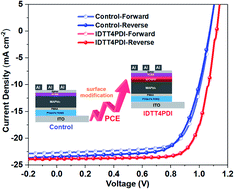A linear conjugated tetramer as a surface-modification layer to increase perovskite solar cell performance and stability†
Abstract
A surface-modification layer is important for the performance and stability of perovskite solar cells, but the research on surface-modification materials is still lagging behind perovskite materials in the photovoltaic field. In this work, a linear conjugated tetramer, IDTT4PDI, was developed through Stille coupling with a high synthetic yield. IDTT4PDI showed excellent solubility, thermal stability, a suitable LUMO level (−4.08 eV), and high electron mobility, implying that it would be suitable for use as a surface-modification layer in inverted perovskite solar cells. The use of IDTT4PDI as a surface-modification layer improved the interfacial contact between the perovskite layer and PCBM film, reduced the trap-assisted recombination, and enhanced the electron transport efficiency. As a result, an efficiency of over 20% is achieved by an IDTT4PDI-modified MAPbI3 perovskite inverted device, which is much higher than that of the control device (17%). This work opens up a new direction for the use of linear perylene diimide derivatives as efficient surface-modification materials for achieving high-efficiency perovskite solar cells.



 Please wait while we load your content...
Please wait while we load your content...